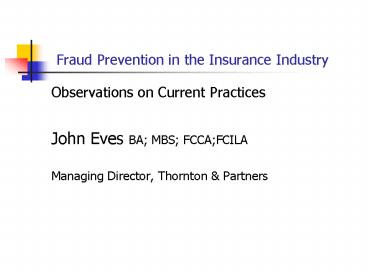Fraud Prevention in the Insurance Industry - PowerPoint PPT Presentation
1 / 26
Title:
Fraud Prevention in the Insurance Industry
Description:
Insurance definition refers to fiction or exaggeration. ... Firewalling. Best Practise Procedures cont'd. Alerts/whistle blowing immunity. ... – PowerPoint PPT presentation
Number of Views:127
Avg rating:3.0/5.0
Title: Fraud Prevention in the Insurance Industry
1
Fraud Prevention in the Insurance Industry
- Observations on Current Practices
- John Eves BA MBS FCCAFCILA
- Managing Director, Thornton Partners
2
FRAUD
- Three functional distinctions.
- Insurance definition refers to fiction or
exaggeration. - Fidelity guarantee i.e. specific cover for
employee misappropriation or fraud. - Transaction Fraud Stewardship aspect.
3
A Loss Adjusters Perspective
- We are the Response Team i.e. reactors.
- Our actions governed by problem presented.
- Investigative Strategy governed by problem
presented. - This may/may not be relevant to you.
4
Outer Frontier Notes
- Lie detection equipment e.g. Halifax voice
modulation changes. - Artifical Intelligence/Data mining.
- Predictive Patterns.
- Conversation Management.
5
In Reality - At the Coal Face
- Fraudsters exploit simple weaknesses.
- Dont look for the complex.
- Look for the blindingly obvious.
- Traditional alerts, followed up by dilligent
work. - Answer lies in best practise systems.
6
General Comment
- Fraudster will always use customer service or
company protocols against you
7
System Problem v- People Problem
- 95 of Errant behaviour is provoked by system,
not people. - Our experience is that fraudsters exploit system
weaknesses, rather than set out to create them. - Opportunities present themselves to fraudsters.
8
Prevention/Detection Framework
- Mission/vision of the organisation.
- Manifestation of that in actual behaviour.
- Percolation.
- Character of working environment i.e. supportive,
fearful, turbulent.
9
Best Practice Procedures
- Contracts of Employment Provisions Re
- Procedures
- I.T. Usage
- Internet Usage
- Photographs
- General PC Access
- Pin number/Password Usage, maintenance and change
routines. - Firewalling.
10
Best Practise Procedures contd
- Alerts/whistle blowing immunity.
- Regulator, statutory or SLA provisions.
- Professional indemnity exposure.
- Monitoring routines.
11
Techniques
- Q.C. Routines.
- Clean processess waste free.
- Intelligent interviewing.
- Mind mapping.
- Registers.
- Information/Database sharing
- Note watch Data Protection Act.
12
Old Reliables
- Independent verification.
- Division of duties.
- Avoidance of collusion.
- Internal audit/anti-fraud.
- Fraud lines.
13
Balancing Act between
- Service
- Cost
- Life cycle
- Expectation
14
What are the pressure points
- Examples are
- Quantum
- Circumstances
- Policy issues
15
Fraud Risk Evaluation
- Traditionally static indicators. This is where
the market is really at. - In time, risk evaluation will look more at
behavioural aspect. - The interaction of the two will hopefully evolve
in to a more holistic approach.
16
Detection v- Prevention
- In reality the big savings in societal cost is in
prevention. - Remove the oppourtunities.
- Exercise good governance.
17
Reputational Aspect in the UK
- Reducing financial crime is one of the FSAs
statutory objectives.
18
What is Fraud?
- Theft by deception
- Fraudulent claim (no claim)
- Fraudulent device (loss suffered but facts
embellished)
19
ABI Definition
- The intentional deception of one party by another
for the purposes of gaining an advantage or
benefit that were the true facts known, would not
be available
20
Examples
- It didnt happen
- Set up/contrive
- Deliberate
- Genuine but overstated
- Genuine loss excluded under the policy but made
to fit - Not owned or no insurable interest
21
Types of Fraudsters
- Oppourtunistic
- Repeat offenders
- Organised
22
Identification
- Method
- Means
- Motive
23
Tools
- Databases (watch Data Protection Act compliance)
- Reasonableness checks e.g. age, size, dates,
description - Personal interview
- Allow people tell their story
- Public Awareness
24
Things to bear in mind
- Exaggeration v- Fraud
- All stakeholders have a role to play
- Insurance industry is not the law we gather
facts - IIF Statement of Practice
- Have referral systems and protocols in place
- Interviewing techniques
25
Indicators
- Inception
- Previous covers
- Undisclosed Claims
- Recent increases in SI
- Circumstances
- Documentation
- Attitude
26
Last Word
- For the Insurance Industry, we are really about
- Effective Validation































